Clinical Practices & Management in Rheumatoid Arthritis (Women)
VerifiedAdded on 2023/06/07
|8
|2443
|275
Report
AI Summary
This report reviews the best clinical practices and management procedures for preventing and controlling rheumatoid arthritis (RA) prevalence in women. It emphasizes early diagnosis, treatment, and patient self-management as key strategies. The review analyzes evidence from various studies, highlighting the importance of early remission and patient empowerment in managing the disease. Barriers to implementation, such as reluctance from clinical officers, are also discussed. The report integrates research evidence with clinical expertise and patient values, advocating for a holistic approach to RA management to improve outcomes for women.
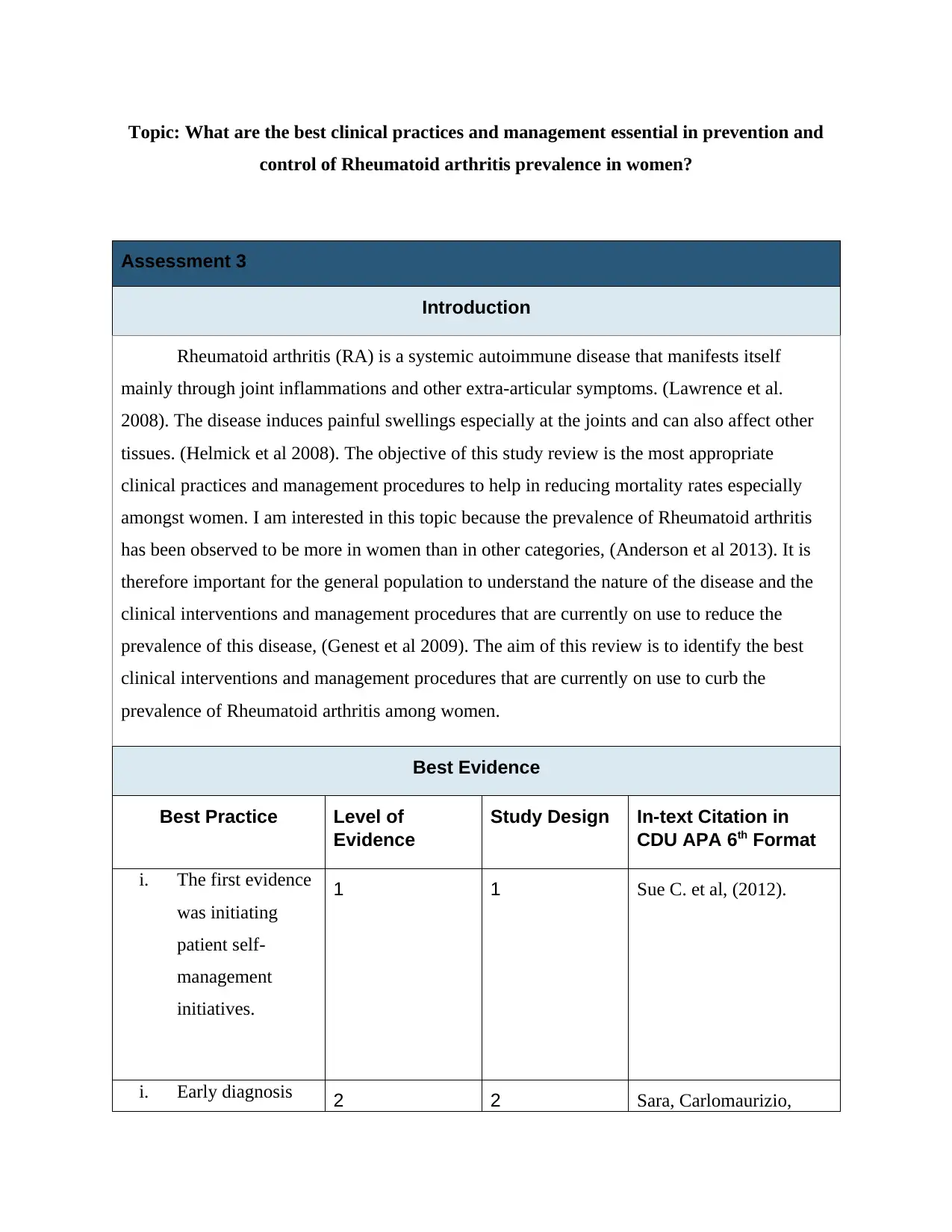
Topic: What are the best clinical practices and management essential in prevention and
control of Rheumatoid arthritis prevalence in women?
Assessment 3
Introduction
Rheumatoid arthritis (RA) is a systemic autoimmune disease that manifests itself
mainly through joint inflammations and other extra-articular symptoms. (Lawrence et al.
2008). The disease induces painful swellings especially at the joints and can also affect other
tissues. (Helmick et al 2008). The objective of this study review is the most appropriate
clinical practices and management procedures to help in reducing mortality rates especially
amongst women. I am interested in this topic because the prevalence of Rheumatoid arthritis
has been observed to be more in women than in other categories, (Anderson et al 2013). It is
therefore important for the general population to understand the nature of the disease and the
clinical interventions and management procedures that are currently on use to reduce the
prevalence of this disease, (Genest et al 2009). The aim of this review is to identify the best
clinical interventions and management procedures that are currently on use to curb the
prevalence of Rheumatoid arthritis among women.
Best Evidence
Best Practice Level of
Evidence
Study Design In-text Citation in
CDU APA 6th Format
i. The first evidence
was initiating
patient self-
management
initiatives.
1 1 Sue C. et al, (2012).
i. Early diagnosis 2 2 Sara, Carlomaurizio,
control of Rheumatoid arthritis prevalence in women?
Assessment 3
Introduction
Rheumatoid arthritis (RA) is a systemic autoimmune disease that manifests itself
mainly through joint inflammations and other extra-articular symptoms. (Lawrence et al.
2008). The disease induces painful swellings especially at the joints and can also affect other
tissues. (Helmick et al 2008). The objective of this study review is the most appropriate
clinical practices and management procedures to help in reducing mortality rates especially
amongst women. I am interested in this topic because the prevalence of Rheumatoid arthritis
has been observed to be more in women than in other categories, (Anderson et al 2013). It is
therefore important for the general population to understand the nature of the disease and the
clinical interventions and management procedures that are currently on use to reduce the
prevalence of this disease, (Genest et al 2009). The aim of this review is to identify the best
clinical interventions and management procedures that are currently on use to curb the
prevalence of Rheumatoid arthritis among women.
Best Evidence
Best Practice Level of
Evidence
Study Design In-text Citation in
CDU APA 6th Format
i. The first evidence
was initiating
patient self-
management
initiatives.
1 1 Sue C. et al, (2012).
i. Early diagnosis 2 2 Sara, Carlomaurizio,
Paraphrase This Document
Need a fresh take? Get an instant paraphrase of this document with our AI Paraphraser
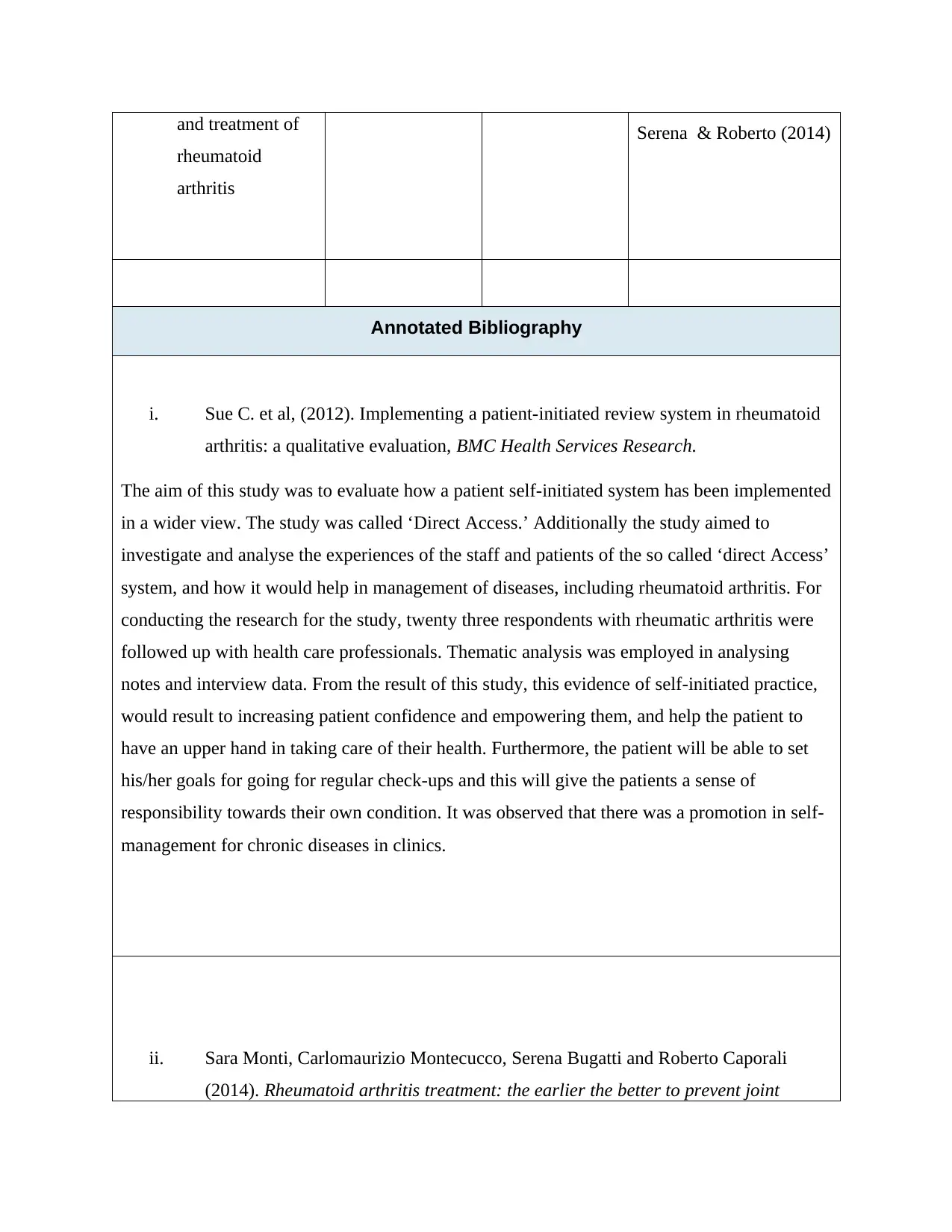
and treatment of
rheumatoid
arthritis
Serena & Roberto (2014)
Annotated Bibliography
i. Sue C. et al, (2012). Implementing a patient-initiated review system in rheumatoid
arthritis: a qualitative evaluation, BMC Health Services Research.
The aim of this study was to evaluate how a patient self-initiated system has been implemented
in a wider view. The study was called ‘Direct Access.’ Additionally the study aimed to
investigate and analyse the experiences of the staff and patients of the so called ‘direct Access’
system, and how it would help in management of diseases, including rheumatoid arthritis. For
conducting the research for the study, twenty three respondents with rheumatic arthritis were
followed up with health care professionals. Thematic analysis was employed in analysing
notes and interview data. From the result of this study, this evidence of self-initiated practice,
would result to increasing patient confidence and empowering them, and help the patient to
have an upper hand in taking care of their health. Furthermore, the patient will be able to set
his/her goals for going for regular check-ups and this will give the patients a sense of
responsibility towards their own condition. It was observed that there was a promotion in self-
management for chronic diseases in clinics.
ii. Sara Monti, Carlomaurizio Montecucco, Serena Bugatti and Roberto Caporali
(2014). Rheumatoid arthritis treatment: the earlier the better to prevent joint
rheumatoid
arthritis
Serena & Roberto (2014)
Annotated Bibliography
i. Sue C. et al, (2012). Implementing a patient-initiated review system in rheumatoid
arthritis: a qualitative evaluation, BMC Health Services Research.
The aim of this study was to evaluate how a patient self-initiated system has been implemented
in a wider view. The study was called ‘Direct Access.’ Additionally the study aimed to
investigate and analyse the experiences of the staff and patients of the so called ‘direct Access’
system, and how it would help in management of diseases, including rheumatoid arthritis. For
conducting the research for the study, twenty three respondents with rheumatic arthritis were
followed up with health care professionals. Thematic analysis was employed in analysing
notes and interview data. From the result of this study, this evidence of self-initiated practice,
would result to increasing patient confidence and empowering them, and help the patient to
have an upper hand in taking care of their health. Furthermore, the patient will be able to set
his/her goals for going for regular check-ups and this will give the patients a sense of
responsibility towards their own condition. It was observed that there was a promotion in self-
management for chronic diseases in clinics.
ii. Sara Monti, Carlomaurizio Montecucco, Serena Bugatti and Roberto Caporali
(2014). Rheumatoid arthritis treatment: the earlier the better to prevent joint

damage 87(7), 659–673.
The aim of this review was to analyse the importance of treating Rheumatoid arthritis
early and the effect this would have on the outcome of diseases, with a specific view on the
prevalence of the disease among women. In this review, the authors have demonstrated that
early diagnosis and treatment of Rheumatoid arthritis, immediate treatment are the basic
initiatives towards realizing positive outcomes in the management of Rheumatoid arthritis.
The authors assert that the efforts that have been put forward to treatment of this disease
realize very little for the management of the disease. According to them, treating diseases with
the aim of its remission using carefully chosen protocols is the standard care on management
of disease. Integrated manual and automated literature searches were conducted using specific
search terms, and from the resulting findings, manual searches were conducted to sanitize the
resulting papers and put together relevant information on the chosen research topic. The
evidence brought forth by this work is that early diagnosis and early treatment is key to
helping improving all radiographic, prognostic, functional and socioeconomic outcomes. This
evidence will be very useful in managing Rheumatoid arthritis, especially amongst women.
iii. Sofia Ajeganova and Tom Huizinga (2012). Sustained remission in rheumatoid
arthritis: latest evidence and clinical consideration. Mayo Clinic Proceedings,
87(7), 659–673.
According to this research, sustained remissions should be the ultimate goal in
treatment and management of Rheumatoid arthritis. The aim of this research is to evaluate and
analyse the impact of early remissions towards realizing sustained remissions on Rheumatoid
Arthritis patients. They assert that sustained remissions are increasing with time, though they
may not have been common historically. They argue that sustained remissions can provide
anti-rheumatic drugs that are instrumental in modifying the disease. They further say that
sustained remission is characterized with positive outcomes in functionality and in favourable
reported outcomes from patients. The research methods used in this research paper is desktop
The aim of this review was to analyse the importance of treating Rheumatoid arthritis
early and the effect this would have on the outcome of diseases, with a specific view on the
prevalence of the disease among women. In this review, the authors have demonstrated that
early diagnosis and treatment of Rheumatoid arthritis, immediate treatment are the basic
initiatives towards realizing positive outcomes in the management of Rheumatoid arthritis.
The authors assert that the efforts that have been put forward to treatment of this disease
realize very little for the management of the disease. According to them, treating diseases with
the aim of its remission using carefully chosen protocols is the standard care on management
of disease. Integrated manual and automated literature searches were conducted using specific
search terms, and from the resulting findings, manual searches were conducted to sanitize the
resulting papers and put together relevant information on the chosen research topic. The
evidence brought forth by this work is that early diagnosis and early treatment is key to
helping improving all radiographic, prognostic, functional and socioeconomic outcomes. This
evidence will be very useful in managing Rheumatoid arthritis, especially amongst women.
iii. Sofia Ajeganova and Tom Huizinga (2012). Sustained remission in rheumatoid
arthritis: latest evidence and clinical consideration. Mayo Clinic Proceedings,
87(7), 659–673.
According to this research, sustained remissions should be the ultimate goal in
treatment and management of Rheumatoid arthritis. The aim of this research is to evaluate and
analyse the impact of early remissions towards realizing sustained remissions on Rheumatoid
Arthritis patients. They assert that sustained remissions are increasing with time, though they
may not have been common historically. They argue that sustained remissions can provide
anti-rheumatic drugs that are instrumental in modifying the disease. They further say that
sustained remission is characterized with positive outcomes in functionality and in favourable
reported outcomes from patients. The research methods used in this research paper is desktop
⊘ This is a preview!⊘
Do you want full access?
Subscribe today to unlock all pages.

Trusted by 1+ million students worldwide

research on reviews, journals and government papers. This paper suggests a drug-free guided
remission, which would be very instrumental in offering early identifications of patients and
treatment of the disease. In the long run, the authors assert that this clinical procedure may
reduce the chronicity of this disease. This evidence would be very instrumental to help in the
management of this disease.
Justifying the Evidence
First Evidence
The evidence, as presented by the authors, is a narrative review that is based on a
research that was done on the importance seeking early diagnosis and treatment of Rheumatoid
arthritis. Combined automated and manual literature seeking techniques was used in
researching for this work, and the resultant papers were searched on to extract relevant
information on the topic being researched on. (Sue et al, 2012). The advantage of this
technique is that it is very effective since it combines both manual and automated searches,
which maximizes the possibility of gathering correct and up to date information on the topic of
research. However, one disadvantage with the process of research was that it is based in one
source of information, which is PubMed. Ideally, the search should have been based on many
sources of information, so as to improve the efficiency of the research. (Smolen et al 2010).
From the results of the research that was done in this work, there are a number of
national and international recommendations that the importance of carrying out early diagnosis
and treatment, (Dougados et al 2013). According to the authors, from the study that was
obtained from clinical trials that were conducted, it was observed that treatment within the first
two weeks of the onset of the disease were particularly effective in curbing the activity of the
disease, which resulted in improved and better long term and short term outcomes. Further, a
specific clinical trial called FinRaCo showed that a delay of up to 4 months is the most
remission, which would be very instrumental in offering early identifications of patients and
treatment of the disease. In the long run, the authors assert that this clinical procedure may
reduce the chronicity of this disease. This evidence would be very instrumental to help in the
management of this disease.
Justifying the Evidence
First Evidence
The evidence, as presented by the authors, is a narrative review that is based on a
research that was done on the importance seeking early diagnosis and treatment of Rheumatoid
arthritis. Combined automated and manual literature seeking techniques was used in
researching for this work, and the resultant papers were searched on to extract relevant
information on the topic being researched on. (Sue et al, 2012). The advantage of this
technique is that it is very effective since it combines both manual and automated searches,
which maximizes the possibility of gathering correct and up to date information on the topic of
research. However, one disadvantage with the process of research was that it is based in one
source of information, which is PubMed. Ideally, the search should have been based on many
sources of information, so as to improve the efficiency of the research. (Smolen et al 2010).
From the results of the research that was done in this work, there are a number of
national and international recommendations that the importance of carrying out early diagnosis
and treatment, (Dougados et al 2013). According to the authors, from the study that was
obtained from clinical trials that were conducted, it was observed that treatment within the first
two weeks of the onset of the disease were particularly effective in curbing the activity of the
disease, which resulted in improved and better long term and short term outcomes. Further, a
specific clinical trial called FinRaCo showed that a delay of up to 4 months is the most
Paraphrase This Document
Need a fresh take? Get an instant paraphrase of this document with our AI Paraphraser
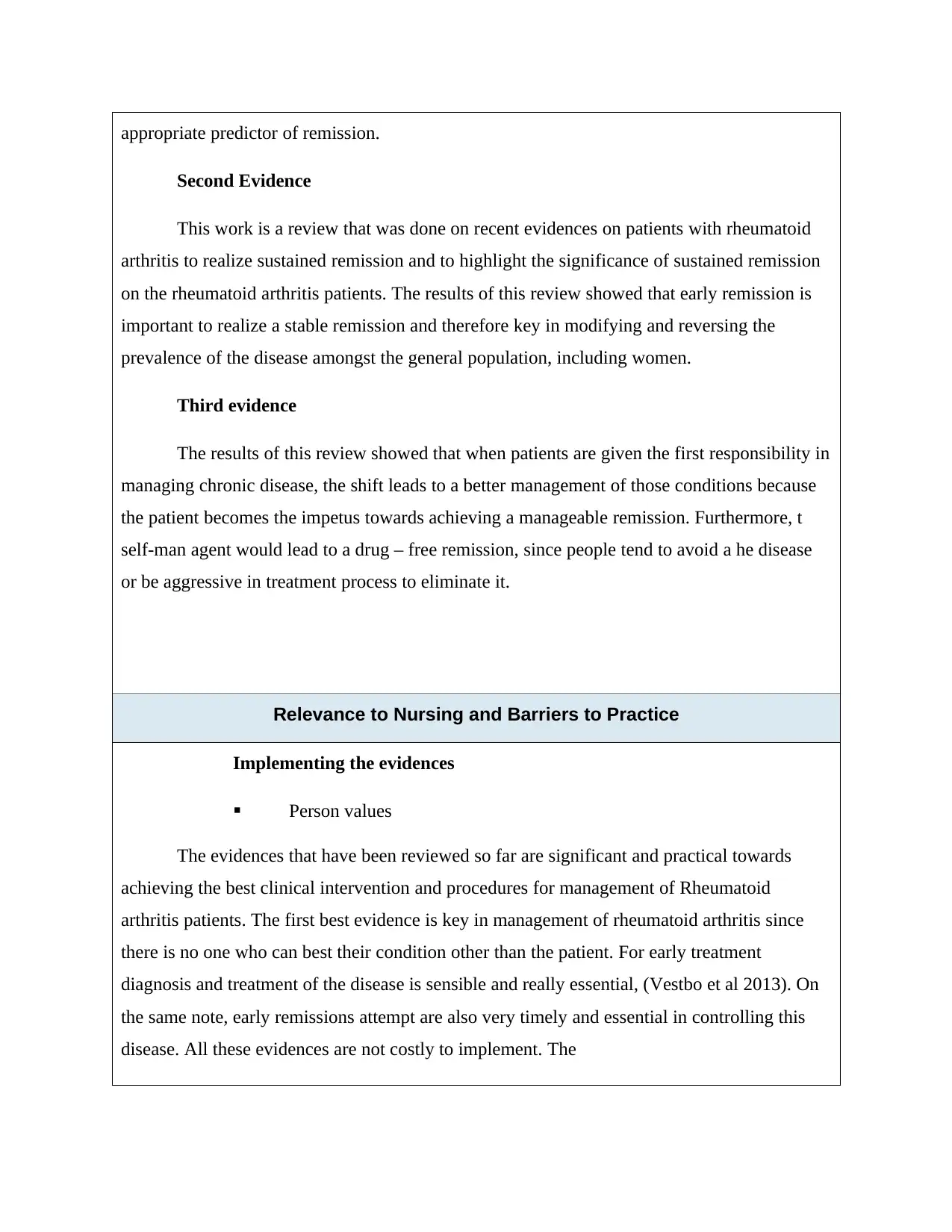
appropriate predictor of remission.
Second Evidence
This work is a review that was done on recent evidences on patients with rheumatoid
arthritis to realize sustained remission and to highlight the significance of sustained remission
on the rheumatoid arthritis patients. The results of this review showed that early remission is
important to realize a stable remission and therefore key in modifying and reversing the
prevalence of the disease amongst the general population, including women.
Third evidence
The results of this review showed that when patients are given the first responsibility in
managing chronic disease, the shift leads to a better management of those conditions because
the patient becomes the impetus towards achieving a manageable remission. Furthermore, t
self-man agent would lead to a drug – free remission, since people tend to avoid a he disease
or be aggressive in treatment process to eliminate it.
Relevance to Nursing and Barriers to Practice
Implementing the evidences
Person values
The evidences that have been reviewed so far are significant and practical towards
achieving the best clinical intervention and procedures for management of Rheumatoid
arthritis patients. The first best evidence is key in management of rheumatoid arthritis since
there is no one who can best their condition other than the patient. For early treatment
diagnosis and treatment of the disease is sensible and really essential, (Vestbo et al 2013). On
the same note, early remissions attempt are also very timely and essential in controlling this
disease. All these evidences are not costly to implement. The
Second Evidence
This work is a review that was done on recent evidences on patients with rheumatoid
arthritis to realize sustained remission and to highlight the significance of sustained remission
on the rheumatoid arthritis patients. The results of this review showed that early remission is
important to realize a stable remission and therefore key in modifying and reversing the
prevalence of the disease amongst the general population, including women.
Third evidence
The results of this review showed that when patients are given the first responsibility in
managing chronic disease, the shift leads to a better management of those conditions because
the patient becomes the impetus towards achieving a manageable remission. Furthermore, t
self-man agent would lead to a drug – free remission, since people tend to avoid a he disease
or be aggressive in treatment process to eliminate it.
Relevance to Nursing and Barriers to Practice
Implementing the evidences
Person values
The evidences that have been reviewed so far are significant and practical towards
achieving the best clinical intervention and procedures for management of Rheumatoid
arthritis patients. The first best evidence is key in management of rheumatoid arthritis since
there is no one who can best their condition other than the patient. For early treatment
diagnosis and treatment of the disease is sensible and really essential, (Vestbo et al 2013). On
the same note, early remissions attempt are also very timely and essential in controlling this
disease. All these evidences are not costly to implement. The

Clinical expertise
From the first evidence, shifting management from clinician first to patients have been
proved to be effective in clinics. According to the second best evidence, there were clinical
studies which were carried out, and the results was improved long term and short term
management of the disease, (D'Haens et al 2008). Additionally, the third best evidence showed
that from a clinical point of view, it would be very easy for clinical officers to achieve a total
remission from drugs when an early remission has been done.
Available research evidence
All the Research that has been done from all the evidences clearly shows that these
evidences, if implemented would be effective in management of rheumatoid arthritis, (Mosca
et al 2011).
Barriers to practice
The only barriers to implementation of these evidences would be reluctance on the part
of clinical officers and stakeholders, (Papaioannou et al 2010).
References
Anderson, T. J., Grégoire, J., Hegele, R. A., Couture, P., Mancini, G. J., McPherson, R., ... &
Genest Jr, J. (2013). 2012 update of the Canadian Cardiovascular Society guidelines
for the diagnosis and treatment of dyslipidemia for the prevention of cardiovascular
disease in the adult. Canadian Journal of Cardiology, 29(2), 151-167.
Dougados, M., Soubrier, M., Antunez, A., Balint, P., Balsa, A., Buch, M. H., ... & Hajjaj-
Hassouni, N. (2013). Prevalence of comorbidities in rheumatoid arthritis and
evaluation of their monitoring: results of an international, cross-sectional study
From the first evidence, shifting management from clinician first to patients have been
proved to be effective in clinics. According to the second best evidence, there were clinical
studies which were carried out, and the results was improved long term and short term
management of the disease, (D'Haens et al 2008). Additionally, the third best evidence showed
that from a clinical point of view, it would be very easy for clinical officers to achieve a total
remission from drugs when an early remission has been done.
Available research evidence
All the Research that has been done from all the evidences clearly shows that these
evidences, if implemented would be effective in management of rheumatoid arthritis, (Mosca
et al 2011).
Barriers to practice
The only barriers to implementation of these evidences would be reluctance on the part
of clinical officers and stakeholders, (Papaioannou et al 2010).
References
Anderson, T. J., Grégoire, J., Hegele, R. A., Couture, P., Mancini, G. J., McPherson, R., ... &
Genest Jr, J. (2013). 2012 update of the Canadian Cardiovascular Society guidelines
for the diagnosis and treatment of dyslipidemia for the prevention of cardiovascular
disease in the adult. Canadian Journal of Cardiology, 29(2), 151-167.
Dougados, M., Soubrier, M., Antunez, A., Balint, P., Balsa, A., Buch, M. H., ... & Hajjaj-
Hassouni, N. (2013). Prevalence of comorbidities in rheumatoid arthritis and
evaluation of their monitoring: results of an international, cross-sectional study
⊘ This is a preview!⊘
Do you want full access?
Subscribe today to unlock all pages.

Trusted by 1+ million students worldwide
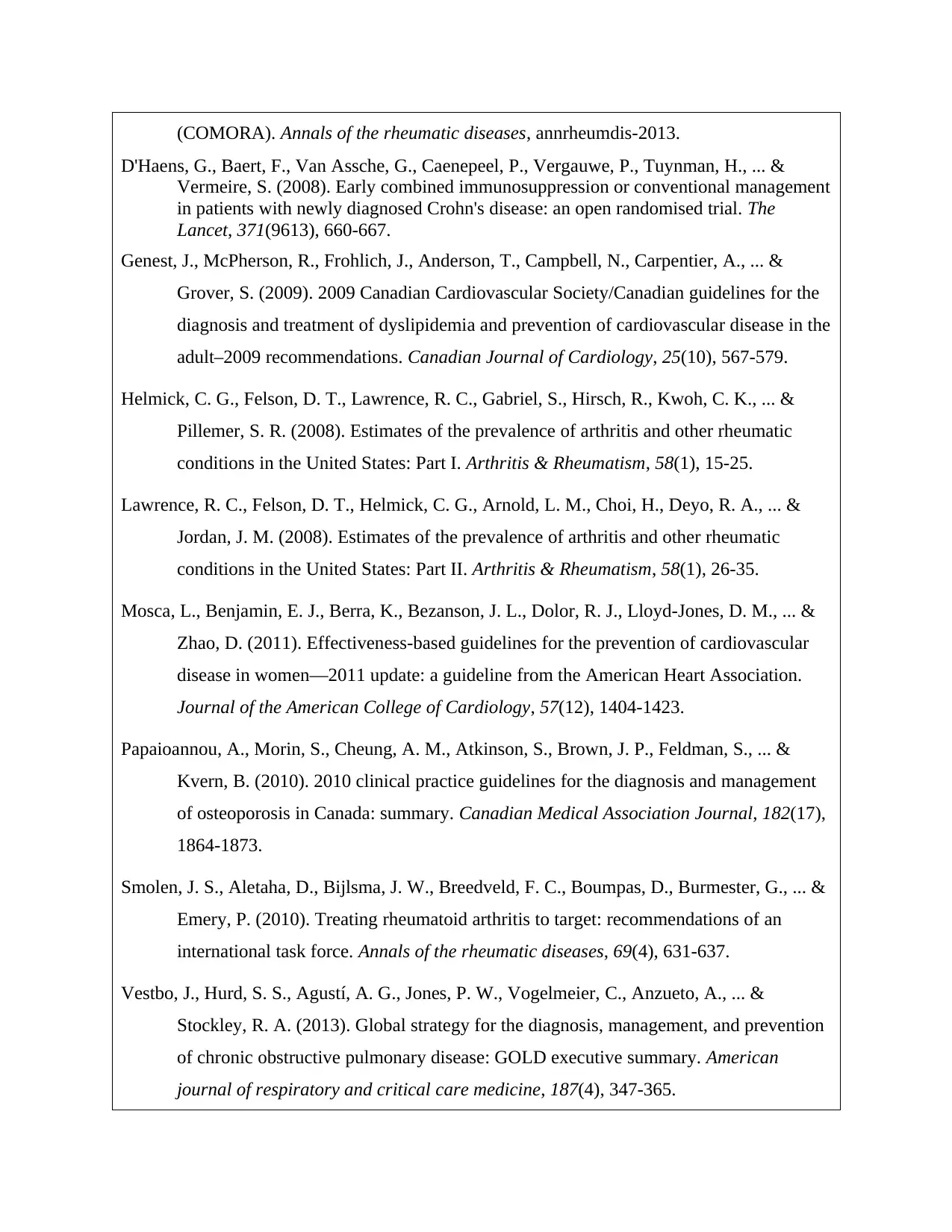
(COMORA). Annals of the rheumatic diseases, annrheumdis-2013.
D'Haens, G., Baert, F., Van Assche, G., Caenepeel, P., Vergauwe, P., Tuynman, H., ... &
Vermeire, S. (2008). Early combined immunosuppression or conventional management
in patients with newly diagnosed Crohn's disease: an open randomised trial. The
Lancet, 371(9613), 660-667.
Genest, J., McPherson, R., Frohlich, J., Anderson, T., Campbell, N., Carpentier, A., ... &
Grover, S. (2009). 2009 Canadian Cardiovascular Society/Canadian guidelines for the
diagnosis and treatment of dyslipidemia and prevention of cardiovascular disease in the
adult–2009 recommendations. Canadian Journal of Cardiology, 25(10), 567-579.
Helmick, C. G., Felson, D. T., Lawrence, R. C., Gabriel, S., Hirsch, R., Kwoh, C. K., ... &
Pillemer, S. R. (2008). Estimates of the prevalence of arthritis and other rheumatic
conditions in the United States: Part I. Arthritis & Rheumatism, 58(1), 15-25.
Lawrence, R. C., Felson, D. T., Helmick, C. G., Arnold, L. M., Choi, H., Deyo, R. A., ... &
Jordan, J. M. (2008). Estimates of the prevalence of arthritis and other rheumatic
conditions in the United States: Part II. Arthritis & Rheumatism, 58(1), 26-35.
Mosca, L., Benjamin, E. J., Berra, K., Bezanson, J. L., Dolor, R. J., Lloyd-Jones, D. M., ... &
Zhao, D. (2011). Effectiveness-based guidelines for the prevention of cardiovascular
disease in women—2011 update: a guideline from the American Heart Association.
Journal of the American College of Cardiology, 57(12), 1404-1423.
Papaioannou, A., Morin, S., Cheung, A. M., Atkinson, S., Brown, J. P., Feldman, S., ... &
Kvern, B. (2010). 2010 clinical practice guidelines for the diagnosis and management
of osteoporosis in Canada: summary. Canadian Medical Association Journal, 182(17),
1864-1873.
Smolen, J. S., Aletaha, D., Bijlsma, J. W., Breedveld, F. C., Boumpas, D., Burmester, G., ... &
Emery, P. (2010). Treating rheumatoid arthritis to target: recommendations of an
international task force. Annals of the rheumatic diseases, 69(4), 631-637.
Vestbo, J., Hurd, S. S., Agustí, A. G., Jones, P. W., Vogelmeier, C., Anzueto, A., ... &
Stockley, R. A. (2013). Global strategy for the diagnosis, management, and prevention
of chronic obstructive pulmonary disease: GOLD executive summary. American
journal of respiratory and critical care medicine, 187(4), 347-365.
D'Haens, G., Baert, F., Van Assche, G., Caenepeel, P., Vergauwe, P., Tuynman, H., ... &
Vermeire, S. (2008). Early combined immunosuppression or conventional management
in patients with newly diagnosed Crohn's disease: an open randomised trial. The
Lancet, 371(9613), 660-667.
Genest, J., McPherson, R., Frohlich, J., Anderson, T., Campbell, N., Carpentier, A., ... &
Grover, S. (2009). 2009 Canadian Cardiovascular Society/Canadian guidelines for the
diagnosis and treatment of dyslipidemia and prevention of cardiovascular disease in the
adult–2009 recommendations. Canadian Journal of Cardiology, 25(10), 567-579.
Helmick, C. G., Felson, D. T., Lawrence, R. C., Gabriel, S., Hirsch, R., Kwoh, C. K., ... &
Pillemer, S. R. (2008). Estimates of the prevalence of arthritis and other rheumatic
conditions in the United States: Part I. Arthritis & Rheumatism, 58(1), 15-25.
Lawrence, R. C., Felson, D. T., Helmick, C. G., Arnold, L. M., Choi, H., Deyo, R. A., ... &
Jordan, J. M. (2008). Estimates of the prevalence of arthritis and other rheumatic
conditions in the United States: Part II. Arthritis & Rheumatism, 58(1), 26-35.
Mosca, L., Benjamin, E. J., Berra, K., Bezanson, J. L., Dolor, R. J., Lloyd-Jones, D. M., ... &
Zhao, D. (2011). Effectiveness-based guidelines for the prevention of cardiovascular
disease in women—2011 update: a guideline from the American Heart Association.
Journal of the American College of Cardiology, 57(12), 1404-1423.
Papaioannou, A., Morin, S., Cheung, A. M., Atkinson, S., Brown, J. P., Feldman, S., ... &
Kvern, B. (2010). 2010 clinical practice guidelines for the diagnosis and management
of osteoporosis in Canada: summary. Canadian Medical Association Journal, 182(17),
1864-1873.
Smolen, J. S., Aletaha, D., Bijlsma, J. W., Breedveld, F. C., Boumpas, D., Burmester, G., ... &
Emery, P. (2010). Treating rheumatoid arthritis to target: recommendations of an
international task force. Annals of the rheumatic diseases, 69(4), 631-637.
Vestbo, J., Hurd, S. S., Agustí, A. G., Jones, P. W., Vogelmeier, C., Anzueto, A., ... &
Stockley, R. A. (2013). Global strategy for the diagnosis, management, and prevention
of chronic obstructive pulmonary disease: GOLD executive summary. American
journal of respiratory and critical care medicine, 187(4), 347-365.
Paraphrase This Document
Need a fresh take? Get an instant paraphrase of this document with our AI Paraphraser
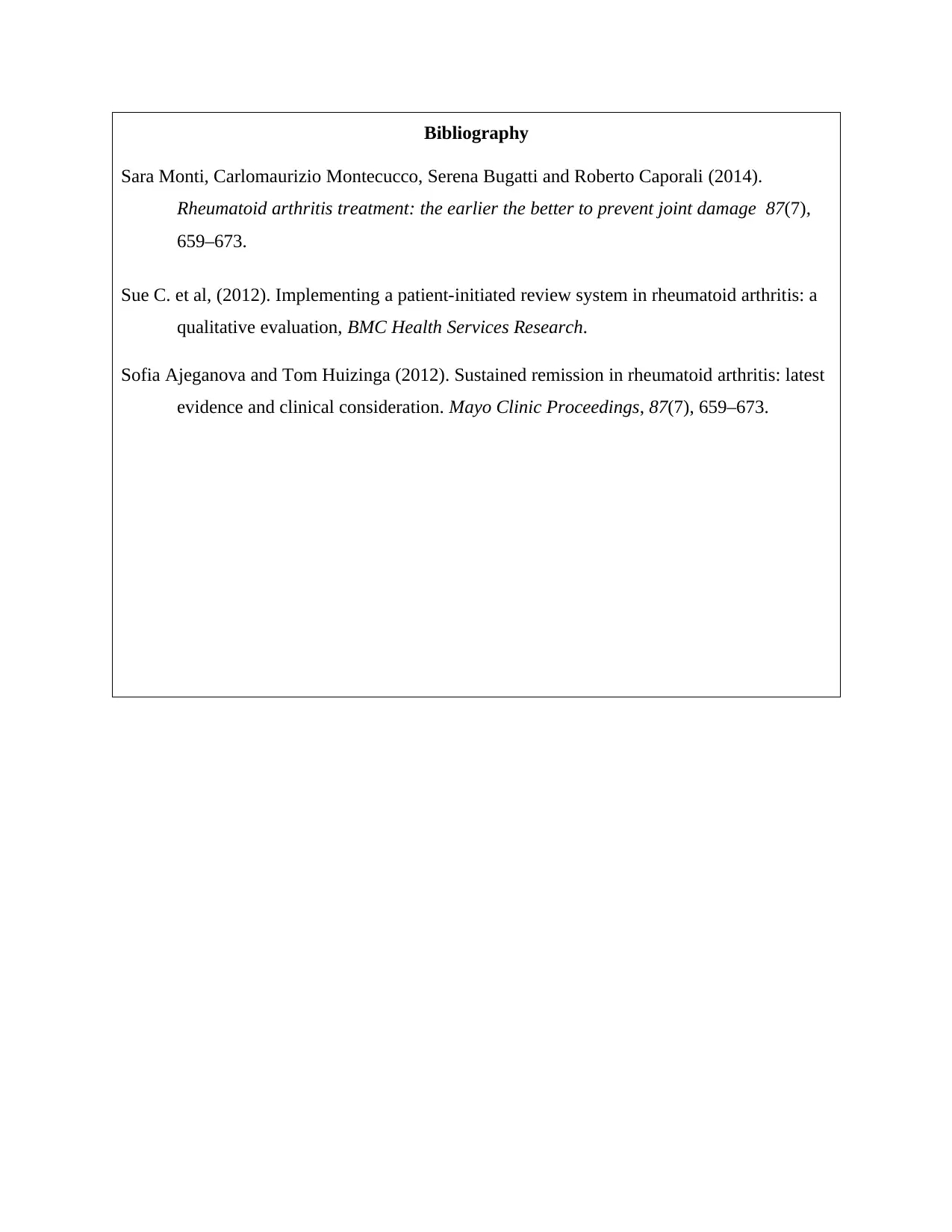
Bibliography
Sara Monti, Carlomaurizio Montecucco, Serena Bugatti and Roberto Caporali (2014).
Rheumatoid arthritis treatment: the earlier the better to prevent joint damage 87(7),
659–673.
Sue C. et al, (2012). Implementing a patient-initiated review system in rheumatoid arthritis: a
qualitative evaluation, BMC Health Services Research.
Sofia Ajeganova and Tom Huizinga (2012). Sustained remission in rheumatoid arthritis: latest
evidence and clinical consideration. Mayo Clinic Proceedings, 87(7), 659–673.
Sara Monti, Carlomaurizio Montecucco, Serena Bugatti and Roberto Caporali (2014).
Rheumatoid arthritis treatment: the earlier the better to prevent joint damage 87(7),
659–673.
Sue C. et al, (2012). Implementing a patient-initiated review system in rheumatoid arthritis: a
qualitative evaluation, BMC Health Services Research.
Sofia Ajeganova and Tom Huizinga (2012). Sustained remission in rheumatoid arthritis: latest
evidence and clinical consideration. Mayo Clinic Proceedings, 87(7), 659–673.
1 out of 8
Related Documents
Your All-in-One AI-Powered Toolkit for Academic Success.
+13062052269
info@desklib.com
Available 24*7 on WhatsApp / Email
![[object Object]](/_next/static/media/star-bottom.7253800d.svg)
Unlock your academic potential
Copyright © 2020–2025 A2Z Services. All Rights Reserved. Developed and managed by ZUCOL.





